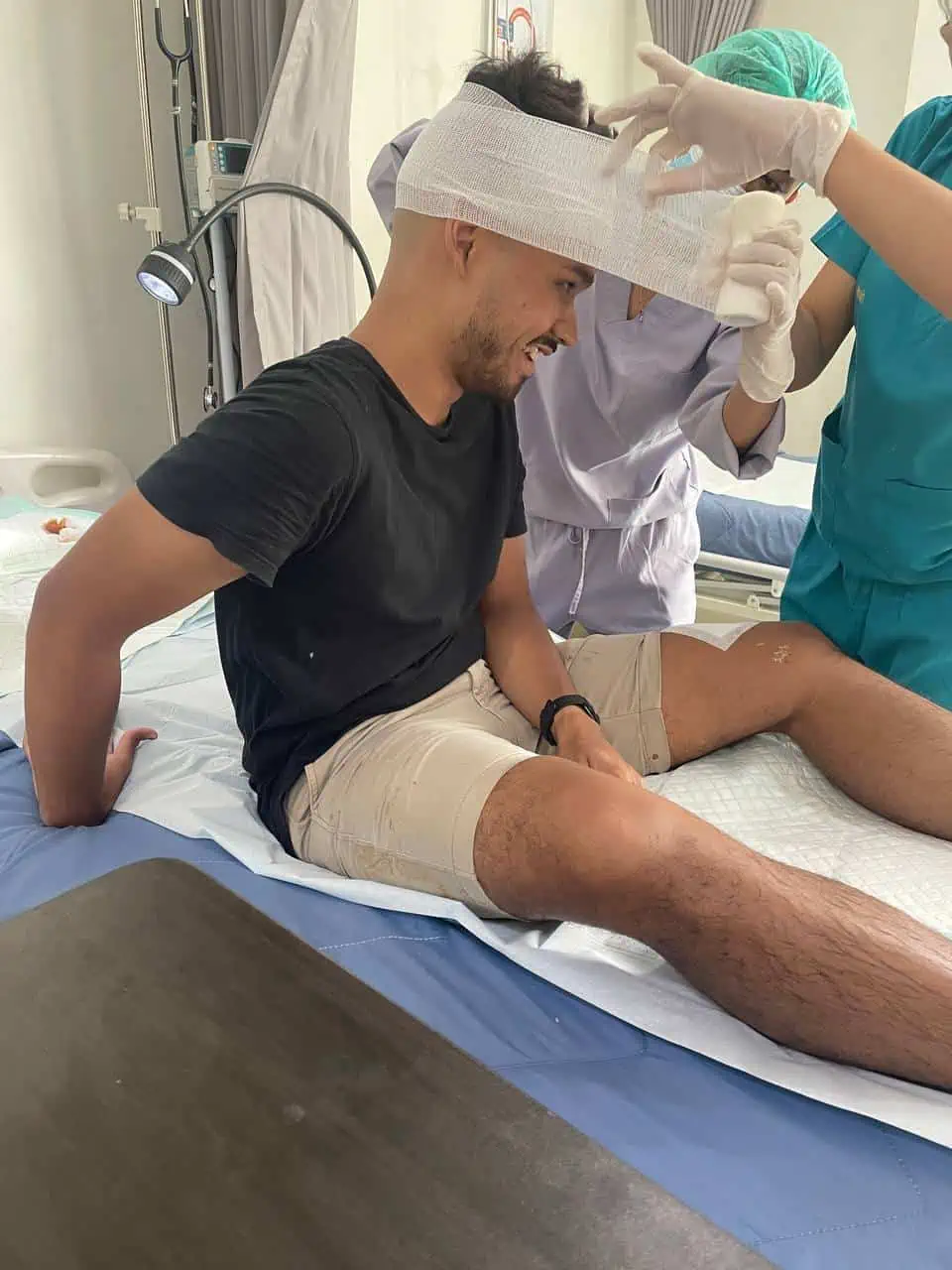Are you planning your next exciting adventure but worrying about the unforeseen circumstances that could potentially ruin it?
Travel insurance is the key to putting your mind at ease and protecting yourself from any unexpected events that may occur while you’re on your trip.
But with so many options available, how do you choose the right travel insurance that meets all your needs?
Don’t fret!
In this post, I’ll guide you through the process of selecting the perfect travel insurance for your next journey – coming from someone who travels frequently for different reasons, from backpacking, to work trips, to adventurous activities.

Whether you’re looking for coverage for medical emergencies, trip cancellations, or lost luggage, I’ll break down the essential factors to consider and provide you with valuable tips to make an informed decision.
By the end of this post, you’ll feel confident and well-equipped to choose the ideal travel insurance policy, allowing you to explore the world with peace of mind.
So let’s dive in and ensure you have the best coverage for your upcoming adventures!
Do you have pre-existing medical conditions?
Got a pre-existing medical condition and planning to travel?
Not all travel insurance policies are created equal, especially when it comes to covering pre-existing conditions.
This means you’ve got to be a bit more selective in your hunt for the perfect travel insurance policy.
First things first, let’s talk about what counts as a pre-existing condition.
It’s any health condition you already have before getting your travel insurance.
The tricky part is that many travel insurance policies might not cover these conditions.
So, if you’ve got one, your options might be a bit limited, but don’t worry, it’s not all doom and gloom.
Start by scouting for travel insurance policies that specifically cover pre-existing conditions.
But here’s the catch – make sure the policy covers your specific condition.
It’s not just about ticking the ‘pre-existing condition’ box but about ensuring your medical situation is covered.
Feeling unsure?
That’s totally normal.
The best move is to get on the phone or hit up the chatbot of the travel insurance companies you’re eyeing.
Ask them straight up if their policy covers your condition.
Choosing travel insurance when you have a pre-existing medical condition isn’t just about finding the cheapest deal or the one with a flashy benefits list.
It’s about finding a policy that fits like a glove with your health needs.
So take your time, ask the right questions, and get that perfect travel insurance policy that lets you travel with confidence.
What’s your purpose of travel?
City Sightseeing: The Safe Bet
Heading to the urban jungles for some city sightseeing?
Good news!
In most cases, a basic travel insurance policy should have you covered.
Cities, with their well-trodden tourist paths and established safety measures, tend to be safer.
So, if your itinerary is packed with museums, cafes, and city tours, you’re likely in the clear with a simple travel insurance plan.
Outskirts Exploration: Up the Ante on Safety
Now if you’re like me and your travel plans take you beyond the city limits, into the less-trodden outskirts, you might need to level up your insurance game.
Why?
Because as you step away from the city’s safety net, risks like theft, accidents, or even unexpected wildlife encounters can increase.
In these scenarios, you’ll want a travel insurance policy that’s a bit more robust, covering these additional risks.
It’s best to be prepared for the unexpected adventures (and misadventures) that come with exploring off the beaten path.
Backpacking Adventures: Higher Risks, Higher Coverage

For the backpackers out there, braving the world with just a backpack, your insurance needs are a bit different.
Backpacking often means staying in hostels, relying on public transport, maybe even hitchhiking.
You’re likely mixing city experiences with excursions to the outskirts.
This blend of travel styles ups the ante on risks.
So, when picking your travel insurance, look for a policy that caters to the unique needs of backpacking.
Think about coverage for lost or stolen backpacks, medical emergencies in remote areas, and more.
It’s about having a safety net that matches your adventurous spirit.
Extreme Sports Enthusiasts: Specialised Coverage is Key

Ah, the thrill-seekers and adventure junkies!
If your travel itinerary includes extreme sports, winter sports, scuba diving, mountain climbing, or any adrenaline-pumping activities, pay extra attention to your travel insurance.
Not all policies automatically cover high-risk adventurous activities.
Some travel insurance plans include these as part of their basic package, while others require add-on coverage.
Before you leap off that cliff or hit the slopes, make sure your policy explicitly covers your chosen activities.
Ensure your high-flying adventures are backed by equally high-flying insurance protection.
Which countries are you going to?
Planning your travel itinerary? Here’s a crucial step: ensure your travel insurance policy covers the countries you’re visiting.
While most travel insurance plans offer a broad range of coverage, spanning numerous countries, there are exceptions.
Particularly, if your travel plans include countries known for higher risks or instability, you might find them excluded from standard policies.
High-Risk Destinations: Extra Caution Needed
When planning a trip to destinations that are considered high-risk, it’s not just about finding a policy that includes them.
It’s also about understanding the risks associated with these places.
Common issues in such areas include theft, pickpocketing (attenzione pickpocket!), and more severe threats like kidnapping or terrorism.
If you’re heading to a country known for higher instances of theft or pickpocketing, it’s crucial to ensure your policy covers these risks.
But that’s not all.
Consider the value of the items you’re bringing along.
For instance, if you’re carrying $10,000 in cash, you’ll want a policy that offers a sum assured high enough to cover such a loss.
It’s all about matching your policy’s coverage to the potential risks and values involved in your trip.
Special Coverage: Fraud, Theft, Kidnapping, and Terrorism
In today’s world, certain risks like fraud, theft, kidnapping, and terrorism are, unfortunately, real concerns in some travel destinations.
When choosing your travel insurance, take a moment to check if these specific risks are covered.
Policies vary greatly in this regard – some might offer comprehensive coverage as part of their standard package, while others might require you to opt for additional coverage.
Remember, the goal is to have a travel insurance policy that not only ticks the box for the countries you’re visiting but also aligns with the specific risks associated with those destinations.
How are you travelling around?
Public Transport: Extra Benefits to Look Out For
Are you planning to navigate your travel destinations via public transport?
If so, you should be aware of a specific feature in travel insurance policies: the Public Transport Cover.
This nifty benefit offers additional payouts in the unfortunate event of an accident while you’re using public transportation.
Whether it’s buses, trains, or metros, if your travel itinerary relies heavily on public transport, this coverage can provide an extra layer of financial protection.
It’s a smart move to check if your chosen travel insurance policy includes this cover, especially if you’re hopping from one place to another using public transit systems.
Don’t believe this is important?
Me neither.
But here’s a picture of a public bus I was in that lost control going downhill. We got into an accident and almost overturned.

Fortunately, no one was injured, but let’s be honest, no one would expect these things to happen.
But if it did happen, this coverage would’ve been great to have.
Renting a Car or Motorbike: Liability is Key
For those of you planning to rent a car or motorbike, there’s another crucial aspect to consider in your travel insurance: rental liability coverage.
Accidents happen, and when they do, you want to be sure you’re covered, not just for damages to the vehicle but also for any liabilities that might arise.
This coverage is typically available as an add-on option in many travel insurance policies.
So, when you’re choosing your policy, make sure this coverage is available and opt for it before you check out.
Drive with confidence, knowing that you’re protected against the unexpected twists and turns that come with road adventures.
Using a Travel Agency: Safeguard Against Insolvency
If your travel plans involve a travel agency, either one arranged from your home country or a local travel provider at your destination, there’s another insurance aspect to consider: coverage for travel agent insolvency.
In the rare but possible event that your travel agency faces financial difficulties or goes bankrupt, this coverage can be a lifesaver.
It ensures that you’re not left stranded or out of pocket due to the agency’s inability to deliver on your travel plans.
When choosing your travel insurance, take a moment to check if it includes protection against travel agent insolvency.
It’s an essential safeguard for ensuring your well-planned trip doesn’t become an unexpected financial burden.
Do you want travel insurance with COVID-19 coverage?
In today’s travel landscape, a critical question to ask yourself is: Do I need travel insurance that covers COVID-19?
With the pandemic reshaping travel norms, not all travel insurance policies have caught up.
If COVID-19 coverage is a priority for you, this becomes a key factor in narrowing down your options.
Why is this important?
Well, COVID-19 has introduced a range of new travel risks – from trip cancellations due to lockdowns to unexpected medical costs if you contract the virus while abroad.
Ensuring your policy covers these scenarios can save you from significant financial and logistical headaches.
Shortlisting Your Ideal Travel Insurance
Up to this point, we’ve explored several unique considerations for choosing your travel insurance policy.
From your travel destinations and modes of transportation to the inclusion of COVID-19 coverage, these factors are crucial in helping you quickly shortlist policies that align with your specific travel needs.
Remember, the goal here isn’t just to find any travel insurance; it’s about finding the one that fits your unique travel plan like a glove.
By focusing on these specific aspects first, you can efficiently narrow down the field to a handful of policies that are most relevant to you.
Once you’ve got your shortlist based on these unique considerations, the next part of your journey involves diving deeper into the details.
The rest of this post will guide you through the points of comparison across all travel insurance policies.
This includes looking at aspects like coverage limits, deductibles, exclusions, and customer service – all essential in making an informed decision.
What is your budget?
Choosing Between Single and Annual Trip Policies
When it comes to travel insurance, one of the first decisions you’ll face is choosing between a single-trip policy and an annual plan.
This choice can significantly impact the price you pay, so it’s worth giving it some thought.
If you’re someone who travels multiple times a year or embarks on longer journeys (each lasting less than 3 months), an annual travel insurance policy might be the way to go to bring your travel insurance premiums down.
It could turn out to be more cost-effective in the long run.
Take it from me – I personally use an annual plan from Etiqa, and it’s been a game-changer.
It not only fits my budget but also aligns perfectly with my travel style.
The Advantage of Group Policies
Now, let’s talk about group travel.
If you’re hitting the road (or the skies) with friends or family, a group policy can be a real money-saver.
Group travel insurance policies are generally more affordable than individual policies, especially when you’re travelling with a larger party.
So, if you’re planning a group adventure, consider opting for a group plan.
It’s a smart move that can lead to significant savings, allowing you to put that extra cash towards more exciting aspects of your trip.
Plus, it simplifies the process – one policy covers everyone, making it easier to manage and keep track of.
Medical-Related Coverage
When selecting a travel insurance policy, one of the most critical aspects to consider is medical-related coverage.
This includes a range of benefits that can significantly impact your safety and financial well-being while travelling.
In the upcoming sections, I’ll be sharing the average and median amounts offered on most single-trip travel insurance policies on their lowest tiers.
Let’s delve into these key areas:
1. Medical Coverage Overseas
Medical emergencies can happen anywhere, and the cost of healthcare abroad can be staggering.
When reviewing travel insurance policies, check the sum assured for overseas medical expenses.
The average sum assured for overseas medical expenses typically ranges around $200,000.
This amount is substantial enough to cover most medical emergencies abroad.
A policy offering significantly more than this average can be considered to have a USP in this area.
This coverage is crucial for handling unexpected medical bills, ensuring you’re not left with a financial burden due to illness or injury abroad.
Personally, this is a huge lifesaver as I’m too eager to eat street food, and the number of times I’ve gotten food poisoning overseas should’ve made me learn my lesson.
I’ve also been in an accident that caused me to be sent to the emergency department, with my head wrapped up in bandages.

You know what’s the best part? I almost didn’t want to get travel insurance for this trip. Thankfully I did.
Don’t mind me laughing, I was trying to internalise the accident and the fact that I just got a haircut just a few hours before it happened.
2. Medical Coverage Back Home
Sometimes, medical issues may require continued treatment upon your return.
Some travel insurance plans extend their coverage to include medical expenses incurred back home from anywhere between 7 to 14 days, related to an illness or injury sustained on your trip.
While not all policies explicitly state the sum assured for medical expenses incurred after returning home, those that do often align with the overseas medical coverage amounts.
This benefit can be a lifesaver, as I’ve fallen sick many times after my trip overseas (definitely not because I wanted to get MC off work, I promise).
3. Emergency Evacuations
In dire situations where medical facilities at your location are inadequate, emergency evacuation coverage becomes essential.
This benefit covers the cost of transporting you to a facility that can provide the necessary medical care.
Look for policies with a high sum assured for emergency evacuations, as these operations can be extremely costly.
The average coverage for emergency medical evacuations is crucial, given the high costs associated with such operations.
Policies offering coverage of around $100,000 to $150,000 are common for lower-tier policies.
4. Accidental Death and Permanent Disability
This coverage provides a lump sum payment in the unfortunate event of accidental death or permanent disability while travelling.
It’s a crucial aspect of travel insurance, offering you or your beneficiaries financial support in extreme cases.
The average coverage in this category varies more widely, with some policies offering around $150,000 to $200,000.
5. Repatriation
In the event of death overseas, repatriation coverage handles the expenses involved in transporting the remains back home.
This usually starts at $100,000, and some policies even offer unlimited coverage for this benefit.
This coverage is not only a financial relief but also provides a sense of comfort, knowing that in the worst-case scenario, arrangements are in place for you or your loved one’s final journey home.
Travel Interruptions
Travel interruptions are an unfortunate but real aspect of travelling, and understanding the coverage for such events in your travel insurance is crucial for any traveller.
This coverage includes trip cancellation or interruption before the trip starts, flight delays and cancellations, and missed connections.
Each of these coverages plays a vital role in safeguarding your travel plans and finances.
Trip cancellation or interruption coverage is essential because it protects you from financial losses due to non-refundable travel expenses.
This situation arises when you’re forced to cancel or cut short your trip due to unforeseen events such as illness, injury, or natural disasters.
The importance of this coverage lies in its ability to provide a safety net for the investments you’ve made in your travel plans.
On average, the coverage amount for trip cancellation or interruption is typically $5,000, offering substantial protection against a wide range of unforeseen events.
Flight delays and cancellations are another critical area covered by travel insurance.
This benefit is particularly important as flight delays and cancellations can lead to a domino effect of additional costs, including the need for extra accommodation or alternative travel arrangements.
The coverage typically compensates you for these inconveniences, often structured as a fixed amount for every 6-hour delay, with average amounts ranging from around $200 to $500.
This coverage is a key aspect of travel insurance, providing financial relief and flexibility in managing unexpected changes to your flight schedule.
Lastly, coverage for missed connections addresses the scenario where you miss a connecting flight or other transport due to a delay in your initial leg of travel.
This type of coverage is crucial as missing a connection can not only disrupt your travel plans but also lead to additional expenses in rebooking flights or making alternative travel arrangements.
The coverage for missed connections usually mirrors that of flight delays, offering a fixed amount for each missed connection.
The average coverage amounts for this are also in the range of $200 to $500, providing a buffer against the ripple effects of travel delays.
Belongings-Related Coverage
When travelling, safeguarding your belongings is as important as ensuring your personal safety.
Travel insurance plays a crucial role in this aspect, offering coverage for the loss of travel documents, personal belongings, expensive gear or equipment, and lost or delayed baggage.
Understanding these coverages can help you choose a policy that best protects your possessions.
Loss of Travel Documents
Losing travel documents like passports or visas can be a traveller’s nightmare, potentially derailing your entire trip.
Travel insurance policies typically cover the costs associated with the loss of these essential documents.
This coverage is vital as it not only helps with the expenses for replacing the documents but also covers any associated costs, such as accommodations while you wait for the replacements.
The average coverage amount for lost travel documents varies, but policies generally offer a substantial sum to cover these expenses, ensuring you’re not left stranded or financially burdened.
Loss of Personal Belongings
Whether it’s clothes, gadgets, or other personal items, losing your belongings can be distressing.
Travel insurance provides coverage for such losses, offering compensation to replace the lost items.
This benefit is particularly important for peace of mind, as it ensures that the financial impact of such losses is minimised.
The coverage amount for personal belongings typically ranges based on the policy, with higher sums offered for more comprehensive plans.
Expensive Gear or Equipment
For travellers carrying expensive gear or equipment, such as cameras, laptops, or sporting equipment, standard coverage might not be sufficient.
Many travel insurance policies offer additional coverage for such high-value items, either included in the policy or as an add-on.
This specialised coverage is crucial for those travelling with costly equipment, providing higher compensation limits to match the value of these items.
For me, this is important as I travel with my laptop a lot for work or even during my leisure trips as I run my business online, so making sure my phone and laptop are insured becomes one of the key factors in choosing a travel insurance plan.

Lost or Delayed Baggage
Lost or delayed baggage is a common travel inconvenience.
Travel insurance policies offer coverage for this, providing compensation for the temporary loss and the expenses incurred while waiting for your baggage.
Travel insurers often provide you with $200 every 6 hours your baggage is delayed, with the claim limit going up to $1,000.
For permanently lost baggage, the policy typically covers the replacement cost of the contents.
The coverage amount for lost or delayed baggage varies among policies, with some offering higher sums to cover more valuable contents.
However, $3,000 is the usual claim limit for baggage loss, but as usual, make sure you check your policy wording.
Others
Beyond the standard coverage for medical emergencies and belongings, there are other crucial features in travel insurance that can significantly enhance your travel experience.
These include 24-hour assistance and the ease of making claims. Let’s explore why these features are important and what they entail.
24-Hour Assistance
Travel can be unpredictable, and having access to 24-hour assistance through your travel insurance is invaluable.
This service typically includes a hotline that you can call at any time, from anywhere in the world, for immediate help.
Whether it’s a medical emergency, a lost passport, or the need for urgent travel advice, 24-hour assistance ensures that you have support available at your fingertips.
The importance of this feature cannot be overstated.
It provides peace of mind, knowing that in any crisis or unexpected situation, you have a reliable point of contact to guide you and offer solutions.
This continuous availability is particularly crucial in different time zones, where local help might not always be readily accessible.
Ease of Making Claims
The ease with which you can file a claim is a critical aspect of any travel insurance policy.
After all, the swiftness and simplicity of the claims process directly impact your experience in times of stress.
A straightforward and user-friendly claims process can make a significant difference, especially when dealing with the aftermath of an unforeseen event during your travels.
When evaluating travel insurance options, consider how claims are handled.
Look for policies with a reputation for easy claim filing procedures, quick response times, and efficient processing.
Many travel insurers now offer online claim filing, which can expedite the process.
Additionally, reading customer reviews and experiences can provide insights into how different insurers handle claims, helping you choose a policy known for hassle-free claim settlements.
While the core coverage of travel insurance is crucial, features like 24-hour assistance and the ease of making claims play a significant role in the overall effectiveness of your policy.
These aspects ensure not only financial protection but also practical support and convenience, making your travel experience smoother and more secure.
What is the recommended amount of travel insurance?
The recommended amount of travel insurance typically depends on your destination, trip duration, and activities planned. Generally, a minimum of $100,000 for medical coverage is advisable, with higher amounts for regions with costly healthcare.
Can you get travel insurance during your trip?
You cannot get travel insurance during your trip as most travel insurers require you to purchase it before your trip. There may be limited options compared to purchasing before departure, with some coverage might not be immediate.
When should you not buy travel insurance?
You should not buy travel insurance if your credit card offers travel insurance, or if your trip involves minimal risks and low costs that don’t warrant additional insurance.
Conclusion
Choosing the right travel insurance is a nuanced process that requires careful consideration of various factors.
Whether it’s assessing coverage for pre-existing medical conditions, understanding the implications of your travel destinations and activities, or considering the mode of transportation, each aspect plays a crucial role in determining the right policy for you.
Additionally, understanding the importance of medical-related coverage, travel interruptions, and belongings-related coverage is essential.
Features like 24-hour assistance and ease of making claims further add to the value of a policy.
Remember, the ideal travel insurance policy is not just about the cost but about finding comprehensive coverage that aligns with your specific travel needs and offers peace of mind throughout your journey.
With the right policy in hand, you can embark on your adventures knowing you’re well-protected against the unexpected.
Enjoy your next trip!










